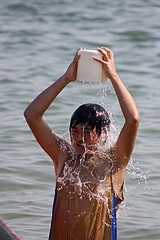Friday, July 15, 2011 - Blog on a Log
Playing it Cool in the Summer Heat
 It's the kind of day you dream about all winter: the sun is shining overhead, there's not a cloud in the sky, and the air is calm around you. You grab your gear, make for the nearest hike/forest/river, and set out on your favourite trail. Back in the spring this route gave you no trouble, but today it isn't long before you start to feel the strain. You grow hot and sweaty, the sun feels relentless, and every movement is an effort.
It's the kind of day you dream about all winter: the sun is shining overhead, there's not a cloud in the sky, and the air is calm around you. You grab your gear, make for the nearest hike/forest/river, and set out on your favourite trail. Back in the spring this route gave you no trouble, but today it isn't long before you start to feel the strain. You grow hot and sweaty, the sun feels relentless, and every movement is an effort.
If you've ever been active on a particularly hot day, you know how easy it can be to overexert yourself. Warm summer weather is a great incentive for getting outdoors, but also brings its own hazards and difficulties. It may have seemed unthinkable as you shivered away six months ago, but summer heat can be just as dangerous as it is pleasant. As you get outdoors this summer it is crucial to always take precautions and listen to your body to avoid overheating and related hazards.
Plan Ahead - There's good reason the siesta is a tradition in hot countries. Mid-day, when the sun and ambient temperature are at their highest, is not the ideal time to be active. When planning summer activities, keep the most strenuous exertion to early mornings, before things get too hot, or later in the afternoon when it begins to cool off. An early start can make all the difference, allowing for a long break, snooze, or swim during the hottest part of the day.
Sweat - it's the body's air conditioning. You wouldn't want to stop it even if you could; it's the best thing your body can do to keep cool. However, it can also cause you to feel itchy and uncomfortable. To minimize discomfort while still keeping cool, wet a handkerchief or Buff in cool water before heading out for the day. Wiping off your face or any particularly bothersome areas can be surprisingly invigorating, giving you the refresher you need to keep going. Sweat running down your face is a common frustration, and can be lessened by wearing a headband or scarf. Heavy antiperspirants are fairly counter intuitive to outdoor pursuits. You're going to stink anyway; you might as well embrace it and let the body get on with what it does naturally.
Hydrate - Losing water may keep your body cool, but it's important to replace it. You should take in a considerable amount of water when active in hot weather - as much as one litre per hour of activity - to protect against dehydration. If you plan to be active all day without access to somewhere to refill a water bottle, a hydration pack may prove a worthwhile accessory, allowing you to carry a large quantity of water comfortably, and drink with ease. A full hydration bladder can even be chilled slightly before heading out (though it should never be frozen, as this will weaken the plastic) providing fresh water and a cooler back for at least part of the day.
Consider Dress - it might seem counter-intuitive, but less is not always more when out in warm weather. On a sunny day, you can stay cooler and lessen your risk of over-exposure by wearing lose, light-coloured that provides coverage from the sun. Some outdoor clothing includes built-in UVA/UVB protection, providing extra defence against sunburn. Remember that the weather can be changeable; as usual when being active outside, it's good to have a few layers or options that allow you to adjust your outfit during the day to suit changing weather patterns (or strip down for a cooling dip if the opportunity presents itself!)
Pace Yourself - most importantly, listen to your body and its needs as you are active throughout the day. There's nothing like getting out while the weather is good, but pushing yourself too hard just ruins the fun. Recall that you may not be able to achieve the same level of activity as you are used to in cooler weather. Take things slow, stay hydrated, and rest if necessary. Heat sickness and other warm-weather hazards do not come on all at once. Prior planning and attention to your body's needs can be the defining factor between an overheated slog and a great summer day out.
Photo: istolethetv on Flickr

